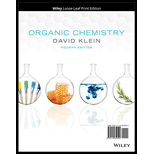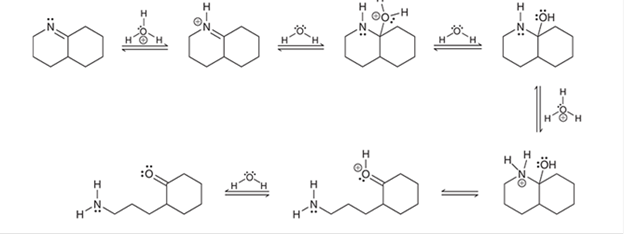
ORGANIC CHEMISTRY-PRINT COMPANION (LL)
4th Edition
ISBN: 9781119659594
Author: Klein
Publisher: WILEY
expand_more
expand_more
format_list_bulleted
Concept explainers
Question
Chapter 6, Problem 39PP
Interpretation Introduction
Interpretation: The curved arrows is to be interpreted for each step of the given mechanism.

Concept introduction: In a
The curved arrows help to determine the movement of electrons, bonds, and reagents. It also shows the attack of electrophile or nucleophile along with loss of leaving group.
Expert Solution & Answer
Want to see the full answer?
Check out a sample textbook solution
Students have asked these similar questions
Draw the mechanism.
I need the curved arrow mechanism for this reaction
Draw all of the products and the mechanism for the reactions below.
Chapter 6 Solutions
ORGANIC CHEMISTRY-PRINT COMPANION (LL)
Ch. 6.1 - Prob. 1LTSCh. 6.1 - Prob. 1PTSCh. 6.1 - Prob. 2ATSCh. 6.2 - Prob. 3CCCh. 6.3 - Prob. 4CCCh. 6.3 - Prob. 5CCCh. 6.4 - Prob. 6CCCh. 6.6 - Prob. 7CCCh. 6.7 - Prob. 2LTSCh. 6.7 - Prob. 8PTS
Ch. 6.7 - Prob. 9PTSCh. 6.7 - Prob. 10ATSCh. 6.8 - Prob. 3LTSCh. 6.8 - Prob. 11PTSCh. 6.8 - Prob. 12ATSCh. 6.9 - Prob. 4LTSCh. 6.9 - Prob. 13PTSCh. 6.9 - Prob. 14ATSCh. 6.10 - Prob. 5LTSCh. 6.10 - Prob. 15PTSCh. 6.10 - Prob. 16ATSCh. 6.11 - Prob. 6LTSCh. 6.11 - Prob. 17PTSCh. 6.11 - Prob. 18ATSCh. 6 - Prob. 19PPCh. 6 - Prob. 20PPCh. 6 - Prob. 21PPCh. 6 - Prob. 22PPCh. 6 - Prob. 24PPCh. 6 - Prob. 25PPCh. 6 - Prob. 26PPCh. 6 - Prob. 27PPCh. 6 - Prob. 28PPCh. 6 - Prob. 29PPCh. 6 - Prob. 30PPCh. 6 - Prob. 31PPCh. 6 - Prob. 32PPCh. 6 - Prob. 33PPCh. 6 - Prob. 34PPCh. 6 - Prob. 35PPCh. 6 - Prob. 36PPCh. 6 - Prob. 37PPCh. 6 - Prob. 38PPCh. 6 - Prob. 39PPCh. 6 - Prob. 40PPCh. 6 - Prob. 41PPCh. 6 - Prob. 43ASPCh. 6 - Prob. 44ASPCh. 6 - Prob. 45ASPCh. 6 - Prob. 46ASPCh. 6 - Prob. 47ASPCh. 6 - Prob. 48ASPCh. 6 - Prob. 49ASPCh. 6 - Prob. 50IPCh. 6 - Prob. 51IPCh. 6 - Prob. 52IPCh. 6 - Prob. 53IPCh. 6 - Prob. 54IPCh. 6 - Prob. 55IPCh. 6 - Prob. 56IPCh. 6 - Prob. 57IPCh. 6 - Prob. 58IPCh. 6 - Prob. 59IPCh. 6 - Prob. 60IPCh. 6 - Prob. 61IPCh. 6 - Prob. 62CPCh. 6 - Prob. 64CP
Knowledge Booster
Learn more about
Need a deep-dive on the concept behind this application? Look no further. Learn more about this topic, chemistry and related others by exploring similar questions and additional content below.Similar questions
- Draw a curved arrow mechanism for the reaction. You can assume that all reactants and products are shown. Add/Remove step CN :C=N:arrow_forward18.04a5 Add curved arrow(s) to draw the final step of the mechanism. H₂O *-* CH3 H3C H3C H₂C H N CH3 Edit Drawing H₂C NO₂ CH3 CH3arrow_forwardDraw the mechanism for this reaction. HO H,SO4.arrow_forward
- Draw the mechanism for the following reaction. HOI FI HOarrow_forwardDraw curved arrows to show the movement of electrons in the step of the mechanism shown below. Arrow-pushing Instructions X→UU :0: :O: || CH3-C-CH₂-C-OEt :OEt :O: || :0: || CH3-C—CH—C—0—OEt + EtO: Harrow_forwardMechanism. Draw complete arrow-pushing mechanisms for the following reactions.arrow_forward
- Show the mechanism for the all the steps involved the following reaction.arrow_forwardDraw the mechanism of the following reactions, using good, curved arrow notation. Describe the HOMO and LUMO interactions in each step of the mechanism. H₂O* H₂O D30+ D₂0arrow_forward5) Use a curved arrow notation mechanism to show how each product is formed in the following reaction. Iderstity-themejor prodret. 0H HzO Br OHarrow_forward
arrow_back_ios
SEE MORE QUESTIONS
arrow_forward_ios
Recommended textbooks for you
 Organic Chemistry: A Guided InquiryChemistryISBN:9780618974122Author:Andrei StraumanisPublisher:Cengage Learning
Organic Chemistry: A Guided InquiryChemistryISBN:9780618974122Author:Andrei StraumanisPublisher:Cengage Learning

Organic Chemistry: A Guided Inquiry
Chemistry
ISBN:9780618974122
Author:Andrei Straumanis
Publisher:Cengage Learning
